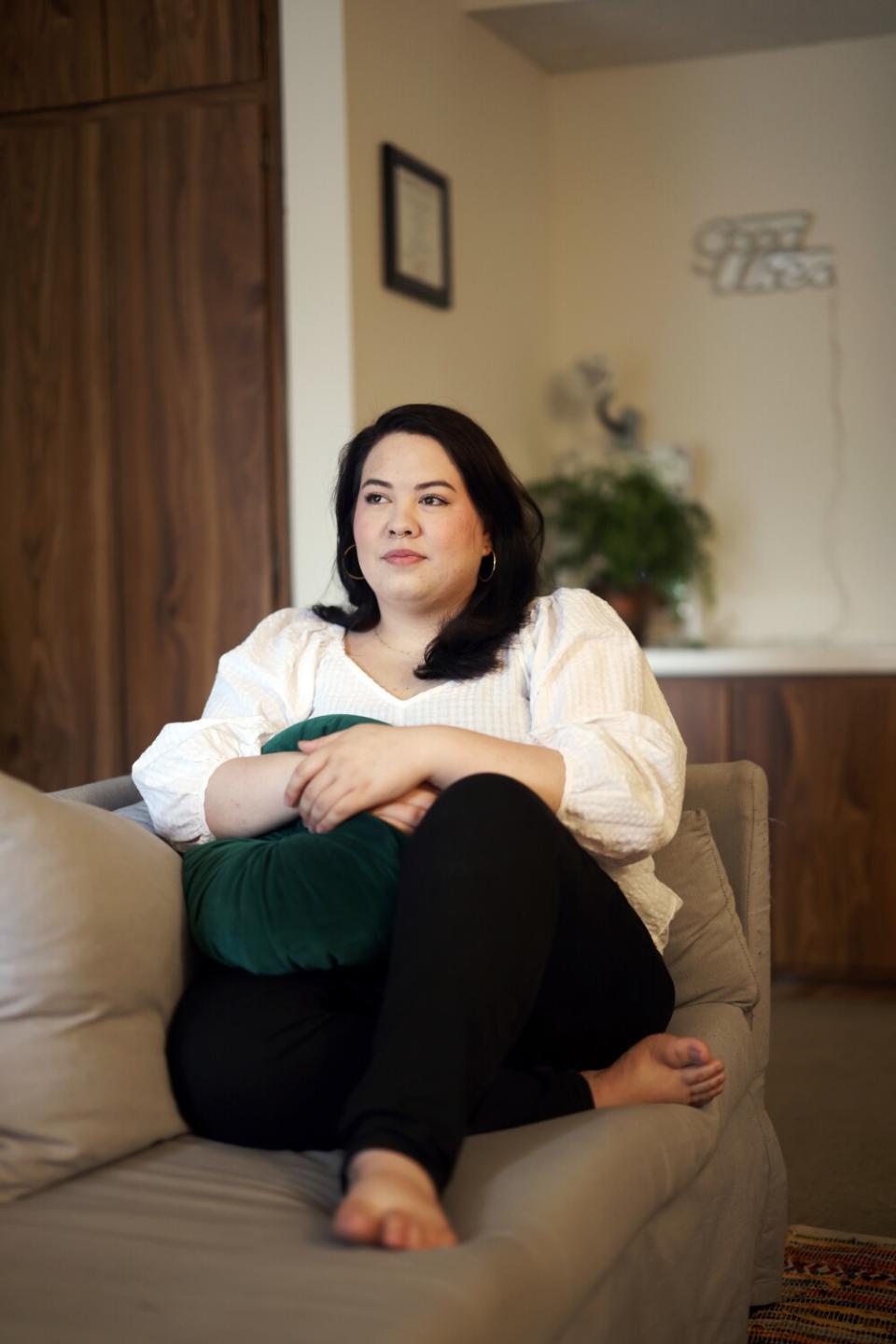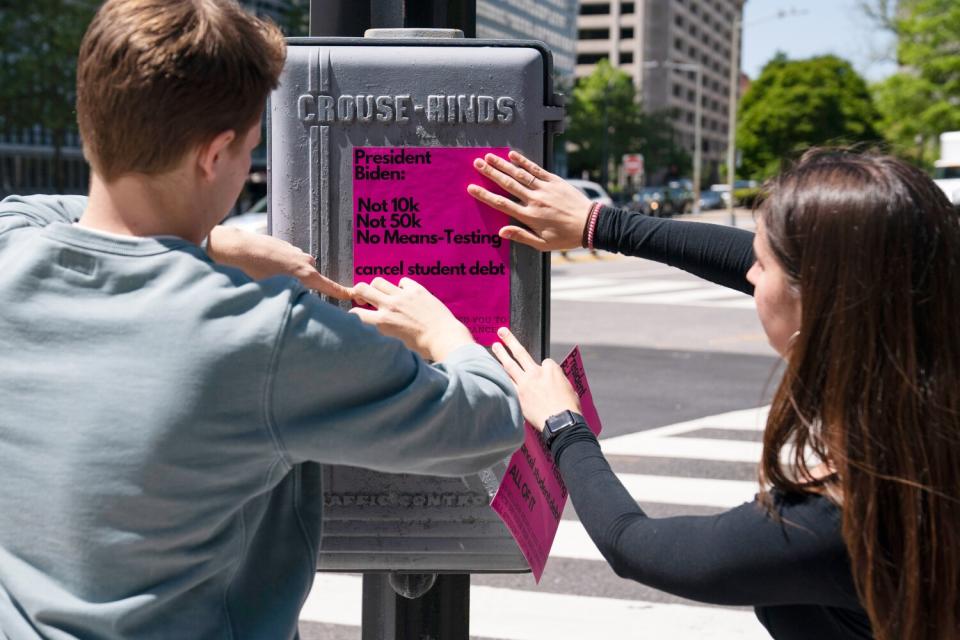Where does student loan forgiveness stand? Borrowers wait anxiously on Biden

Kayla Camacho was halfway through her master’s degree when federal student loan payments were paused in March 2020.
When she graduated last year, she put the money she would have spent paying off her $68,000 debt toward savings and her younger siblings, buying flights home to Orange County for one sister and dance shoes for another. The first in her family to graduate from college, Camacho became the family’s safety net.
But the pandemic pause in payments was always meant to be temporary. Camacho and tens of millions of other borrowers have braced for months as the pause’s expiration date approached, only to be postponed multiple times. It is now set for Aug. 31.
“The uncertainty and the waiting game — the not knowing — is almost as stressful,” she said.
The pause and accompanying 0% interest rate have given borrowers a chance to breathe and regroup, allowing them to spend the last two years paying off credit cards and car notes, saving for down payments on homes and building up emergency funds, sometimes for the first time.
Now, ahead of the midterm election, the Biden administration must come up with a student debt relief plan that doesn’t contribute to concerns over inflation while being generous enough to satisfy borrowers who’ve had a preview of what debt cancellation might look like. After months of delays, President Biden is expected to announce in coming weeks that the government will forgive at least $10,000 in debt for people making less than $125,000 a year.
If the move survives an expected legal challenge, it would eliminate a significant chunk of debt for millions of borrowers — the average federal student loan burden is $37,000. In total, 43million Americans owe the government $1.6 trillion, the biggest share of consumer debt in the U.S. after mortgages. In California alone, 3.8 million residents owe $141.8 billion, the largest share of any state.

But depending upon whom is asked, $10,000 in forgiveness for some borrowers is too much — or not enough. Opponents of loan forgiveness say it would be expensive and regressive, with the biggest benefit going to borrowers with graduate degrees, who tend to have higher incomes.
“My main concern is that it’s a really poor use of money,” said Marc Goldwein, senior policy director at the nonpartisan Committee for a Responsible Federal Budget. The plan “is really going to help some people, but it’s disproportionately going to go to people who don’t need it.”
Supporters of debt cancellation want the president to go higher than $10,000, to ensure the break is granted automatically without an application process, and to remove the income cap, which they say would hurt Black and Latino borrowers who have less generational wealth and are disproportionately affected by student debt. Black and Latino borrowers generally take longer to pay off their student loans and are more likely to fall behind on payments than white and Asian borrowers.
“We need debt cancellation that really is designed in a way that benefits as many Americans as possible,” said Cody Hounanian, executive director of the Student Debt Crisis Center, which backs complete loan forgiveness.
Biden also faces increasing pressure to end the repayment pause. Republicans have complained about the cost, an estimated $5 billion per month, and say it’s an attempt to improve Biden’s approval ratings ahead of the election, and a gateway to debt cancellation.
Meanwhile, some Democrats have pushed for the president to cancel up to $50,000 in debt. They warn that doing nothing to help all borrowers isn’t a viable option, particularly ahead of midterm elections in which Democrats need the backing of younger voters to help defend slim majorities in the House and Senate.
The government’s federal student loan portfolio has grown more than fivefold since 2004, when it totaled $250 billion. That increase has been spurred by more students going to college, borrowing larger amounts and taking longer to pay the money back, according to the Congressional Budget Office.
“Before the payments were paused, another student loan borrower defaulted on a loan every 26 seconds,” said Mike Pierce, executive director of the advocacy group Student Borrower Protection Center, referring to people who are 270 days behind on payments. “No one should be rushing to go back to that world without actually fixing student loans and debt.”

The debt has hurt borrowers’ ability to buy homes and save for retirement. For many, the debt has become an obstacle to achieving the middle-class life college was meant to help provide.
Camacho said she always considered higher education a given. Paying for it was the question.
“Going to college was something that was viewed as, ‘You need to go to college so you can get a good job, and so you don’t have to continue that cycle of poverty,’” said the 29-year-old, who pays $1,750 a month for a studio apartment in Anaheim.
Her parents, high school sweethearts who had her young, struggled at times to make ends meet. Camacho recalled that unexpected emergencies such as a car breaking down meant the family had to ask for help or turn to payday loans. In 2012, while she was in college, they lost their home.
Her parents rented apartments in a wealthy Orange County suburb with good schools so Camacho and her three younger siblings would have more opportunities. It paid off: She took Advanced Placement classes and got good grades. She spent six years in show choir and wrote about the experience in her college application essays.
In 2010, Camacho enrolled in Chapman University, a private four-year institution near her hometown that offered a generous financial aid package. She lived at home and paid for school with a combination of scholarships, money earned from retail and on-campus jobs, and thousands of dollars in federal student loans.
Camacho earned a bachelor’s degree in English in 2014, started working as a high school English teacher through Teach for America that same year, and began to pay back the loan.
“At the end of the month it would be zero,” she said, referring to her bank balance. “I didn’t have any extra money.… That [loan] auto pay just becomes a looming thing that you try to forget about, but it’s always in the back of your mind.”
After two years in the classroom, she began working to support new teachers with Teach for America. She returned to Chapman in 2018 for a master’s degree in leadership development, taking on even more debt.

If she could do it again, she would ignore the advice she received as a high school senior to enroll in the best school possible, regardless of the cost.
“Luckily, it all led me to where I am today, which is great — but with a very hefty bottle of loans,” she said.
When payments resume, she’ll owe $429 a month — about 12% of her take-home pay — under the terms of her 20-year repayment plan for both her undergraduate and graduate debt.
Supporters and opponents of loan forgiveness agree that it’s not sustainable to continue extending the current moratorium. For borrowers, the longer the pause lasts, the more difficult it might be to stay current with payments.
“All hell will break loose if and when this thing is restarted,” Dalié Jiménez, director of the Student Loan Law Initiative at the UC Irvine School of Law, said of resuming loan repayment. “This requires quite a bit of ramp-up ... to be done well.”
Borrowers may have changed addresses, making it harder for their loan servicers to reach them, or they may have failed to budget for repayment, Jiménez said.
Then there’s the cost of forgiveness. The U.S. Department of Education estimated that loan forbearance due to COVID-related hardships resulted in $98.4 billion in lost revenue in the 2020 and 2021 fiscal years.
According to the Committee for a Responsible Federal Budget, that amount is double what it would have cost to fund two years of community college for Americans over the course of five years, a provision in Biden’s failed social spending bill.
If Biden opts to cancel $10,000 in debt for each student loan borrower, that would cost $321 billion and wipe out debt for nearly
12 million people, according to the Federal Reserve Bank of New York.
“It was a great emergency measure,” Sandy Baum, a senior fellow at the Urban Institute’s Income and Benefits Policy Center, said of the extended moratorium. “But now the unemployment rate is really low. It’s not that people don’t have jobs. … People are as well-positioned to pay off their loans as they were before the pandemic.”
There’s a primary reason Biden has been hesitant to address student debt without Congress.

“It’s very likely that it’ll get challenged in court, which would then delay or prevent any of the forgiveness that was promised to borrowers,” said Michelle Dimino, a senior education policy advisor at Third Way, a centrist Democratic think tank.
Dimino noted that for most of his presidency, Biden has been more focused on better enforcement of existing student loan debt relief laws, which has led to billions in forgiveness for students who are disabled or were defrauded by their schools.
The administration also issued a temporary waiver to make it easier to have loans forgiven under a program for those who work in public service, which has led to $6.8billion in debt cancellation for 113,000 borrowers, according to the Education Department.
But as November’s midterm elections approach, debt cancellation advocates say incremental change isn’t enough.
“People are looking for [Biden] to make good on the promises he made on the campaign trail,” said Kristin McGuire, executive director of Young Invincibles, a group that promotes the interests of young voters.
Recent polling indicates there’s support among Democrats and independents for at least some loan forgiveness, particularly if it’s targeted to those who need it most.
In a Morning Consult poll in December, 62% of registered voters supported some form of debt forgiveness, either for all borrowers or for those with low incomes. Supporters included 85% of registered Democrats, 57% of independents and 43% of Republicans. Millennials showed the most support for loan forgiveness of any age group, with nearly 80% supporting some debt cancellation and 34% approving of canceling all debt.
The question now is whether borrowers will be happy returning to the status quo after two years of life without student loans.
“I think I’m just a pretty average millennial, and that there’s a lot of us,” Camacho said. “We have student loans; it’d be great if they were forgiven, and we could do a lot of things in our lives if that was the case.”
This story originally appeared in Los Angeles Times.

